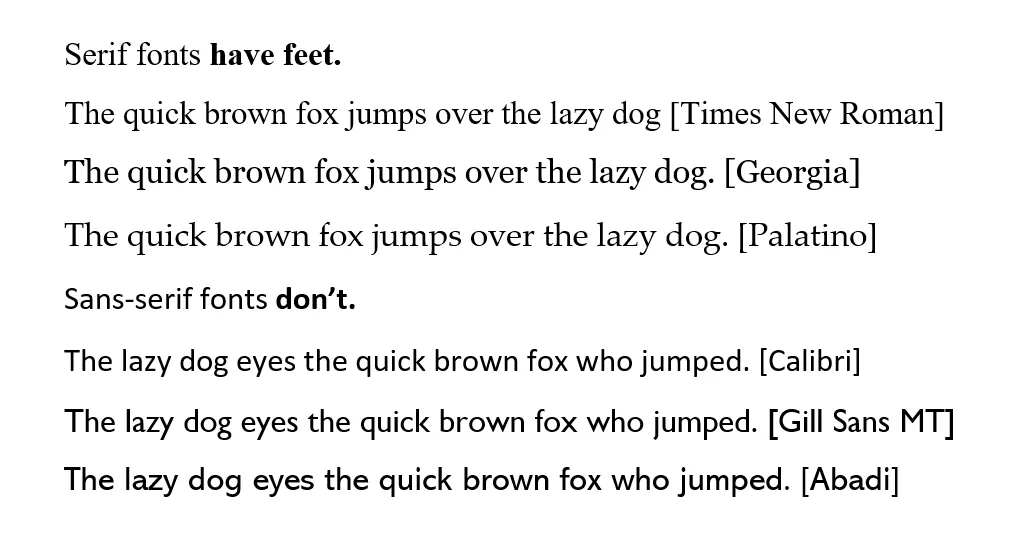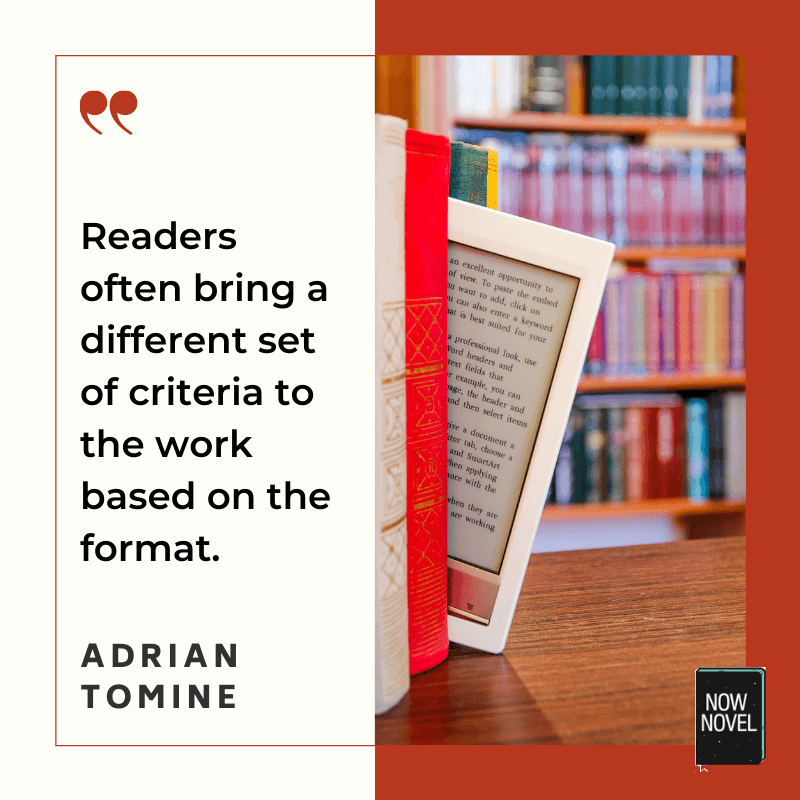Consistent, neat book formatting matters. Layout, spacing, margins, font (typography and font size), plus other details factor into the legibility and appeal of your manuscript. Read 8 tips to ensure you format your book well, whether you plan to publish in print or digitally:
How to format your book for publication
- Understand formatting books for print vs digital
- Stick to crisp serif or sans-serif fonts
- Set your book’s style upfront for consistency
- Match formatting to medium or device
- Add page numbers for print, position in book for MOBI
- Check spacing (use proper page breaks)
- Check paragraph break conventions for your genre
- Get help from formatting pros if needed
Let’s explore how to format your manuscript in closer detail:
1. Understand formatting books for print vs digital
Book formatting refers to aspects of layout, typography, paragraph spacing, chapter page styling and more.
Your book’s formatting should match the effort you have put into content and cover design. Professionalism in appearance shouldn’t stop after front pages.
Formatting for print i.e. physical books, versus formatting books for digital publication differs in several key ways:
Differences between formatting for print vs digital publication
Common formatting decisions between print and digital books include:
- File format: Will you export your book or story to PDF or EPUB or other formats? Whether you’re publishing digitally or physical copies, you need to export to format suited to your purpose. Are you using Word or Google docs? You will need to do some research on what’s best for your needs. Google docs now offers ePub as a native file export, for example.
- Chapter page design: Will you make the first line of a chapter all caps (a common formatting choice), or use drop caps for the first letter on a chapter? These are formatting considerations for print and digital pubbing
- Page breaks: It’s no fun when you upload your manuscript to a digital and/or print merchant and all your carefully separated chapters run together. For print and digital publishing, inserting page breaks manually ensures that in conversion your chapter breaks are preserved.
Formatting digital books: Key differences
How you format digital books depends on where and how your readers will read them.
This is the biggest difference between digital and print formatting: Print books have fixed layouts and design elements such as font type and size, whereas digital layouts such as ePub permit font size, type and alignment to be changed on the fly (we call this ‘reflowable’ layout).
Digital formatting and fixed vs reflowable layouts
‘Reflowable’ layout means that the same number of words don’t always fit on the viewport of a reading device. Font size or type can be changed on an e-reader and this changes how many words are fit to display on each page automatically. Reader-made changes will alter what portion of the text is visible on the screen at a time.
It’s important to remember, when choosing formats for digital publication:
- Images are tougher for reflowable layout than text. If you have a book with many illustrations, text boxes or images, PDF with its fixed layout would be the better option (it is the standard file format for print due to being immovable and thus preserving formatting choices)
- You don’t need page numbers for EPUB books for devices such as Amazon Kindle. Since progress/page depth can change depending on adjustable font size or fonts, a static page number doesn’t make sense. Conversion tools for eBook creation such as Vellum allow you to switch from page numbers to progress-based indicators like you find in Kindle books
Dave Chesson of Kindlepreneur has an excellent guide to book file format types and the formats the major book merchant platforms accept.
Digital vs print and color considerations
Digital vs print books also use different color systems. This is only really a concern for images such as cover designs or in-text images (which you would not use in a simpler, more text based e-reader book format).
Digital design and marketing agency Bluegrass gives a concise summary of key print vs digital differences:
MYK, RGB, and HEX are three of the main formats. For printing, the color format that is often used is called CMYK. Note that CMYK stands for cyan, magenta, yellow, and k (which represents black). On the other hand, HEX and RGB color formats are used for digital designs. RGB is based on 3 colors that you can see looking at any computer monitor. They are red, green, and blue. Six digit codes known as HEX codes define the spectrum of all possible permutations of these 3 colors.
Margaret Foster, for Bluegrass, ‘Differences between Print and Digital Design’
Now Novel’s course How to Publish and Promote Your Novel includes a workbook on formatting to make beautiful books with further tips, tool comparisons and more.
Popular book formatting tools for digital and print include Vellum,
2. Stick to crisp serif or sans-serif fonts
If you want a readable, neat manuscript and final ebook or print novel, steer clear of curlicue fancy fonts with names like Shelley (sorry, Shelley) or ‘a yummy apology’. You don’t want half the letters to come out looking like wingdings. On the other hand, you can use decorative fonts occasionally: perhaps as the titles for chapters, for instance.
Crisp, serif fonts (‘serif’ referring to the little extra lines on letters such as feet) – Times New Roman, Georgia, Palatino – are widely used and easy to read.

Simpler sans-serif fonts (Calibri, Gill Sans, Abadi) are readable (and often more ‘modern’ looking) and, like serif fonts, can’t be confused with a GP’s scrawl.
This applies both to book formatting (preparing for publication) and manuscript formatting (preparing a presentable manuscript to query agents or publishers that accept unsolicited manuscripts). Penguin Random House SA advises (in addition to 1.5 line spacing):
Use a serif font like Times New Roman, Garamond or Century, size 12.
Lulu has a great, succinct article on choosing the best font for your book, including popular favorites for romance and other genres.

Prepare to launch your book
Join a course led by multi-published authors and learn how to publish and promote your book.
Learn more3. Set your book’s style upfront for consistency
One of the most crucial values to uphold in book formatting is consistency.
Avoid:
- Mixing font for the same material-type (e.g. multiple fonts of narrative/paragraph-style text)
- Mixing spacing types between the same type of content (e.g. having single spaces between some paragraphs or lines or words and double between others)
To ensure your book formatting looks uniform and is legible and doesn’t rip your reader out of your story, make style choices in advance and stick to them. Keep a one-page style sheet summary of:
- Paragraph, chapter heading and subheading font specifications
- Spacing conventions
- Chapter title page layout and styling elements (for example, whether you will capitalize the first row of text in each chapter using small caps as some books do, or use drop caps – that decorative, large first letter in a chapter)
- Decide what your digital table of contents will look like

If you want to apply the same style to the first paragraph of each chapter in your book, see Kindle Direct Publishing’s simple video on how to do this in Microsoft Word below:
4. Match formatting to medium or device
Some layout considerations depend on publishing medium.
For example, you won’t need to calculate the spine width for cover design if your book will be digital only – because it’s spineless.
What to remember if formatting your book for digital distribution:
- It is harder to control widows (paragraphs that end with a short line at the top of a new page), orphans (a paragraph that begins at the bottom of the page and shows as one line) and other awkward-looking formatting in reflowable book formats than when you work with fixed type where you can shift things around and then freeze in place.
- Images are tricky and many digital reading devices either only support black and white or have very low display resolution for images
Once you know whether you will sell your book in physical, digital or both formats, read up about each format and what you need to do to ensure your book looks great.
If you are planning to publish on Amazon, then Kindle Direct Publishing has a handy knowledge base giving all the manuscript formatting steps so that you can list your book on the biggest digital book merchant platform with confidence.

5. Add page numbers for print, position in book for ePub
As mentioned above, print and digital publication differs in that the former requires page numbers, the latter, position in book or page numbers (if publishing in a format such as PDF that allows page numbers).
If using Microsoft Word, there is a handy guide to inserting page numbers in Word in their knowledge base.
6. Check spacing (use proper page breaks)
Spacing is another important element in formatting your book.
Avoid using automatic tools to create spacing that looks good in your current word processor. For example, pressing Enter or Return to move text to a new page or using the ‘Tab’ key for hard indents.
The problem with creating spaces between paragraphs or from margins this way is that it is not as exact as setting and applying a spacing rule that will apply to all sections of similar styles and translate when converting your book to other formats.
For shifting text to a new page, such as starting a new chapter, insert a page break. In Microsoft Word, you click ‘Insert’ in the toolbar, then ‘page break’, with your cursor at the end of the line that you want to be the last of the preceding page.

Self-Publishing School offers helpful extra pointers on formatting mistakes to avoid.
7. Check paragraphing conventions for your genre
Fiction books typically indent new paragraphs, whereas non-fiction books sometimes (though not always) use block paragraphs rather than indents (as the SPS article above mentions). The type of book you have written will determine your layout.
The best practice is to know your genre and check books recently published in your genre for paragraphing and other formatting conventions.
This will give you an idea of current practice, as well as options for how to format your book so it looks modern (and doesn’t stick out on shelves virtual or physical for the wrong reasons – as the ugly duckling).
8. Get help from formatting pros if needed
If formatting your book seems overwhelming, or you aren’t good with visual detail, use a book formatting professional.
Someone who has formatted many books and knows the layout shortcuts will save you a lot of time.
Learn DIY book publishing prep and marketing from a USA Today bestselling author and get formatting help.


6 replies on “Book formatting: 8 tips for readable books”
New authors often underestimate the importance of good formatting. Some great tips and advice! Thanks!
Thanks, Clayton, thank you for reading our blog and taking the time to comment.
This post is very helpful for my next projects. I notice different valid points in this article. I will try to use these tips in my upcoming projects.
Thanks.
Thank you Oliver, thanks for your feedback and for reading our articles.
How do I format a book?
Hi there, thank you for sharing your question. That is a very broad question but some do’s and don’ts:
– Do use proper page and line-level indentation settings rather than tab for indents as this is more consistent and avoids conflicts if multiple people are working on the same document.
– Do look at publishers’ guidelines for submissions as they usually give a good indication. Most want at least 1.5 line spacing, for example, as it makes it much easier to read.
– Do consider hiring a professional to format your book (or else use software such as Vellum which has a premium but can output tidier manuscripts with less fuss).
– Do be consistent in things such as margins, spacing (between words and how you space lines, paragraphs, etc.). Mixed styles are often a tell something hasn’t been formatted professionally.
– Don’t use an odd font (no comic sans) – something crisp and ‘ordinary’ (ish) is the norm (e.g. a serif font).
– Don’t use tiny or enormous print (around 12-point print is fairly standard).
You can find more formatting guidelines on the web but I’d strongly recommend either learning the ins and outs thoroughly enough to do a good job or hiring someone to do it. Reedsy gives cover page and other templates here and there are many further resources you can find.